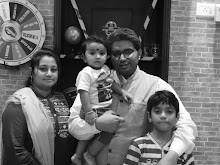On the occasion of the 97th birth anniversary of the legendary Naushad (born on 25 Dec 1919), I append few points from his life and career stolen from the internet:
• When he got married, the band was playing the tunes of the super hit songs of the film 'Rattan'. While his father and father-in-law were condemning the musician who had composed these songs, Naushad dared not tell them that it was he who had composed the music.
• His greatest contribution was to bring Indian classical music into the film medium. Naushad's style was renowned for his ability to incorporate classical rhythms into his symphonies. He based his music upon the "ragas" that formed a basis in Indian classical music, and thus his music took on complex formations
• He often spent nights sleeping on the footpath opposite the Broadway theatre in Bombay, and dreamt of seeing his music played over there. Sixteen years later, he burst into tears at the premiere of Baiju Bawra (1952), at that same theatre.
• He also introduced the accordion to Hindi film music and was among the first to concentrate on background music to extend characters' moods and dialogue through music.
• He is known for introducing Lata Mangeshkar, Mohd Rahi and Surayya to the scale that we know today.
• For Aan (1952), he was the first to use a 100-piece orchestra.
• For Mughal-e-Azam (1960) song Ae Mohabbat Zindabad, he used a chorus of 100 persons. He asked Lata Mangeshkar to render a part of the song "Pyaar Kiya To Darna Kya" in a bathroom that had glazed tiles and then recorded the music to get the echo effect.
• During the early 1940s, his recordings were done in quiet parks and gardens after midnight because the studios did not have sound-proof recording rooms. In the gardens there would be no echo and disturbances, unlike the studios where the sound reverberated because of the tin roofs.
• From 1942 until the late 1960s, he was one of the top music directors in Hindi films. While he did less than a hundred films during his lifetime, 26 of those films celebrated Silver jubilees (25 weeks run) – 8 celebrated golden jubilees (50 weeks run) and 4 celebrated diamond jubilees (60 weeks run).
• Five films have been made on his life and work. Biographical books published are Dastaan-E-Naushad (Marathi) by Shashikant Kinikar; Aaj Gaawat Man Mero (Gujarati); Hindi and Urdu biographical sketches in Shama & Sushma Magazines respectively, titled "Naushad Ki Kahani, Naushad Ki Zubani"; the last one was translated into Marathi by Shashikant Kinikar. Kinikar also came up with a book titled "Notes of Naushad" which puts together some interesting anecdotes of Naushad's life.
• His greatest contribution was to bring Indian classical music into the film medium. Naushad's style was renowned for his ability to incorporate classical rhythms into his symphonies. He based his music upon the "ragas" that formed a basis in Indian classical music, and thus his music took on complex formations
• He often spent nights sleeping on the footpath opposite the Broadway theatre in Bombay, and dreamt of seeing his music played over there. Sixteen years later, he burst into tears at the premiere of Baiju Bawra (1952), at that same theatre.
• He also introduced the accordion to Hindi film music and was among the first to concentrate on background music to extend characters' moods and dialogue through music.
• He is known for introducing Lata Mangeshkar, Mohd Rahi and Surayya to the scale that we know today.
• For Aan (1952), he was the first to use a 100-piece orchestra.
• For Mughal-e-Azam (1960) song Ae Mohabbat Zindabad, he used a chorus of 100 persons. He asked Lata Mangeshkar to render a part of the song "Pyaar Kiya To Darna Kya" in a bathroom that had glazed tiles and then recorded the music to get the echo effect.
• During the early 1940s, his recordings were done in quiet parks and gardens after midnight because the studios did not have sound-proof recording rooms. In the gardens there would be no echo and disturbances, unlike the studios where the sound reverberated because of the tin roofs.
• From 1942 until the late 1960s, he was one of the top music directors in Hindi films. While he did less than a hundred films during his lifetime, 26 of those films celebrated Silver jubilees (25 weeks run) – 8 celebrated golden jubilees (50 weeks run) and 4 celebrated diamond jubilees (60 weeks run).
• Five films have been made on his life and work. Biographical books published are Dastaan-E-Naushad (Marathi) by Shashikant Kinikar; Aaj Gaawat Man Mero (Gujarati); Hindi and Urdu biographical sketches in Shama & Sushma Magazines respectively, titled "Naushad Ki Kahani, Naushad Ki Zubani"; the last one was translated into Marathi by Shashikant Kinikar. Kinikar also came up with a book titled "Notes of Naushad" which puts together some interesting anecdotes of Naushad's life.
A small common element with Sadhna whose Ist death anniversary also falls today: Mere Mehboob

No comments:
Post a Comment